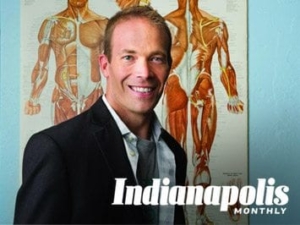Life Can Change in an Instant.
On August 8, 2010 Chris Leeuw was an active, athletic, 28-year old enjoying the prime of his life. An avid waterskiier and drummer, and a lover of sports and the outdoors, on this day he was kayaking with two friends in southern Indiana.
A few hours into the trip they approached an abandoned bridge that crossed the river. In need of a break from the blazing sun, they decided to climb up and jump off into the water below.
After a few successful leaps, Chris went for an extra thrill and climbed to the top of the truss, which stood 40-50 feet above the water. He took a moment to admire the scenery among the treetops, counted to 3, and took the plunge that would forever change his life.
Another jumper landed directly on Chris’ head as they struck the water simultaneously. The C4 and C5 vertebrae in Chris’ neck were shattered instantly, leaving his 6’2 200lb pound body floating paralyzed from the neck down.
The spinal cord injury Chris suffered was significant. Initially, he had little hope of ever gaining significant movement. Following surgery that fused his second through sixth cervical vertebrae, he spent a week in the ICU. It was 6 days before he was fed his first soft food and there was any signs of hope. The first thing he remembers consciously moving was a flicker in his inner thigh. The next day he was moved to a Rehabilitation Hospital.
Chris and his family were thrown into the world of quadriplegia, the horrors of a body broken, a life changed, and the potential permanence of the situation. But, he was eager to begin physical therapy and had dreams of defying the odds and walking out of the building.
Unfortunately, he would not get the chance.
Early on, there were positive signs that Chris had the potential for recovery. Within the first month he could move a few muscles in his right leg and hand. These were small movements but huge victories, and proof that at least some signals were making there way down his injured spinal cord. There were daily set-backs, frustrations, complications, and injustices that everyone with a spinal cord injury must face. Too often his therapy schedule was interrupted with fainting, nausea, urinary tract infections, staph infections, fevers, blood clots, and fatigue.
Recovery from neurologic injury is incredibly slow, and it soon became evident that Chris was running out of time. In spite of an excellent insurance plan, his coverage to remain at the rehab hospital and to continue the therapy he needed would soon expire. The injured quickly become victims of statistics, as insurance companies put a cap on coverage. His family fought hard to keep him in therapy as long as possible. In spite of his documented gains, Chris was discharged 8 weeks after his injury.
Chris had to leave the one place he thought represented hope for him to improve.
His body was still mostly paralyzed. He needed multiple people to transfer him to a chair, bath, dress, and care for him. His blood pressure could only tolerate being upright in a chair for minutes at a time. He looked over a therapy gym full of equipment he hoped he could eventually use as his therapy progressed, but before his body was ready for it – Chris was forced to leave.
He remembers that day being the single hardest day for his emotions to handle.
There were two options.
- Move home, hire a nursing staff, remodel the house and find a van transport to attend 60 minute therapy sessions twice a week until that too expired after 30 visits.
- Move to nursing home that, while unequipped to care for a recent quadriplegic, may provide some therapy.
His family researched all the nursing homes in the area and found one that offered physical and occupational therapy.
The therapists at this facility were not experts in SCI, but were caring and extremely dedicated. After initially being wheeled in on a stretcher, over the course of 4 months he gradually learned to sit, transfer from bed to chair, stand, rid himself of catheters and bowel programs, and actually take steps with a platform walker.
Insurance ran out again (this time at the subacute level) in early 2011. Chris was still wheelchair bound, but he was making great progress. He simply needed more time, and was determined to find access to the best resources in the world for neurologic recovery.
The Leeuw family was introduced to Neuroworx, a specialty clinic for spinal cord injury in South Jordan, Utah. Dr. Dale Hull, and DPT Jan Black founded Neuroworx in 2004 after Dr. Hull suffered a spinal cord injury. Hull and Black discovered there was a void in recovery options for people recovering from injury, and they did something about it.
Chris and his mother Monice (who had become his caregiver) traveled to Neuroworx in February of 2011. There, he was able to spend a year and a half intensely working to relearn and rebuild what he could. His efforts, and the access he had to a remarkable therapy team with a remarkable vision paid off. By May of 2012, Chris had left his wheel chair and cane behind and was bicycling a recumbent bike, driving a car, and able to return to independent living.
Chris’s experience changed his life. In 2013, he and his family founded NeuroHope as a 501 c 3 public charity to follow the example set by Neuroworx and the Christopher and Dana Reeve Foundation to create a continuum of care center in Indiana. In 2015, NeuroHope opened its doors to its first patients in a small room supplied by the University of Indianapolis Krannert School of Physical Therapy. In the years since, through expansion support from Indiana CTSI (through the Department of Health), the OrthoIndy Foundation, and generous support from the community, NeuroHope has launched a multi-disciplinary team, and has helped hundreds of families on the the road to recovery.

